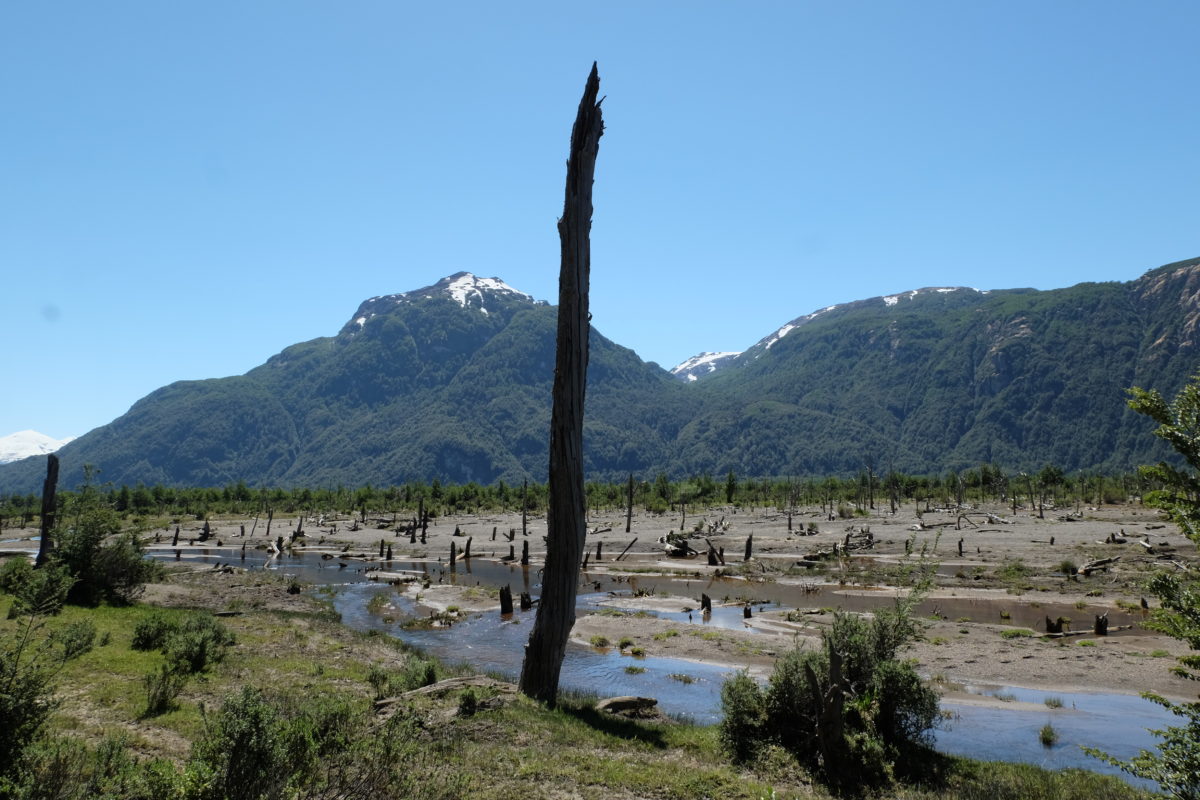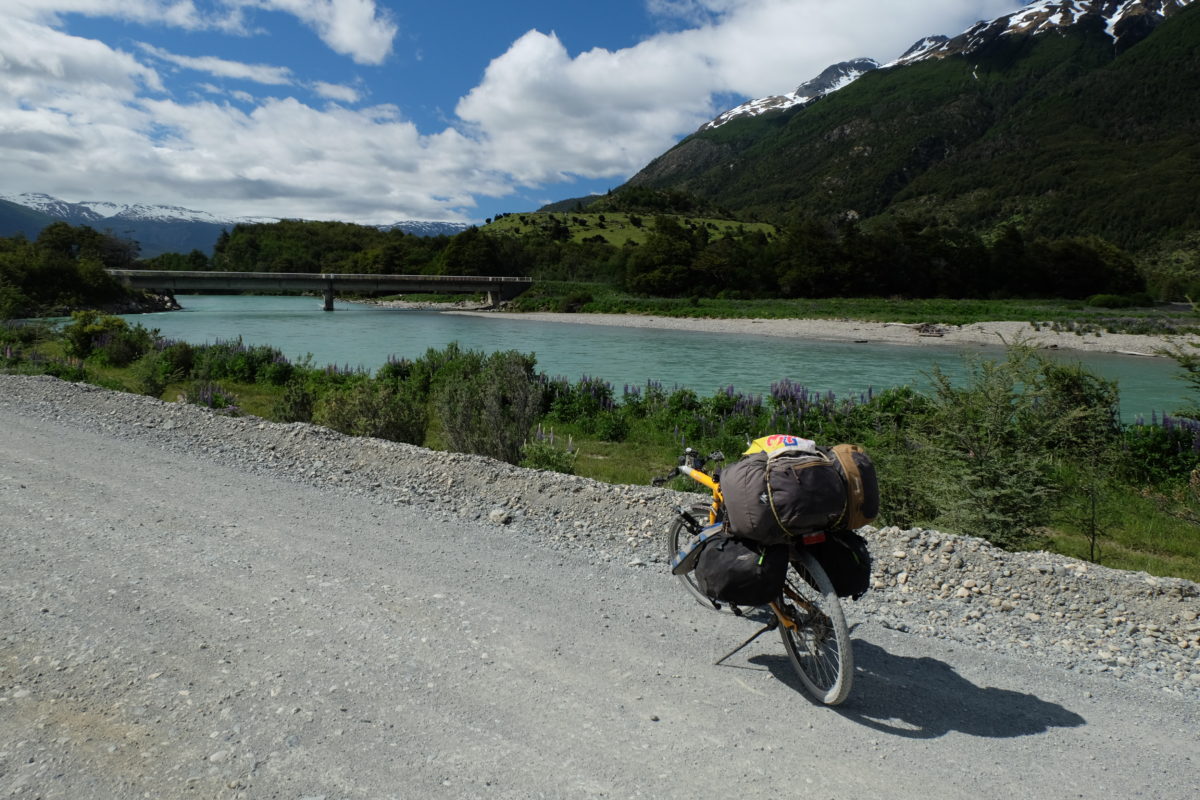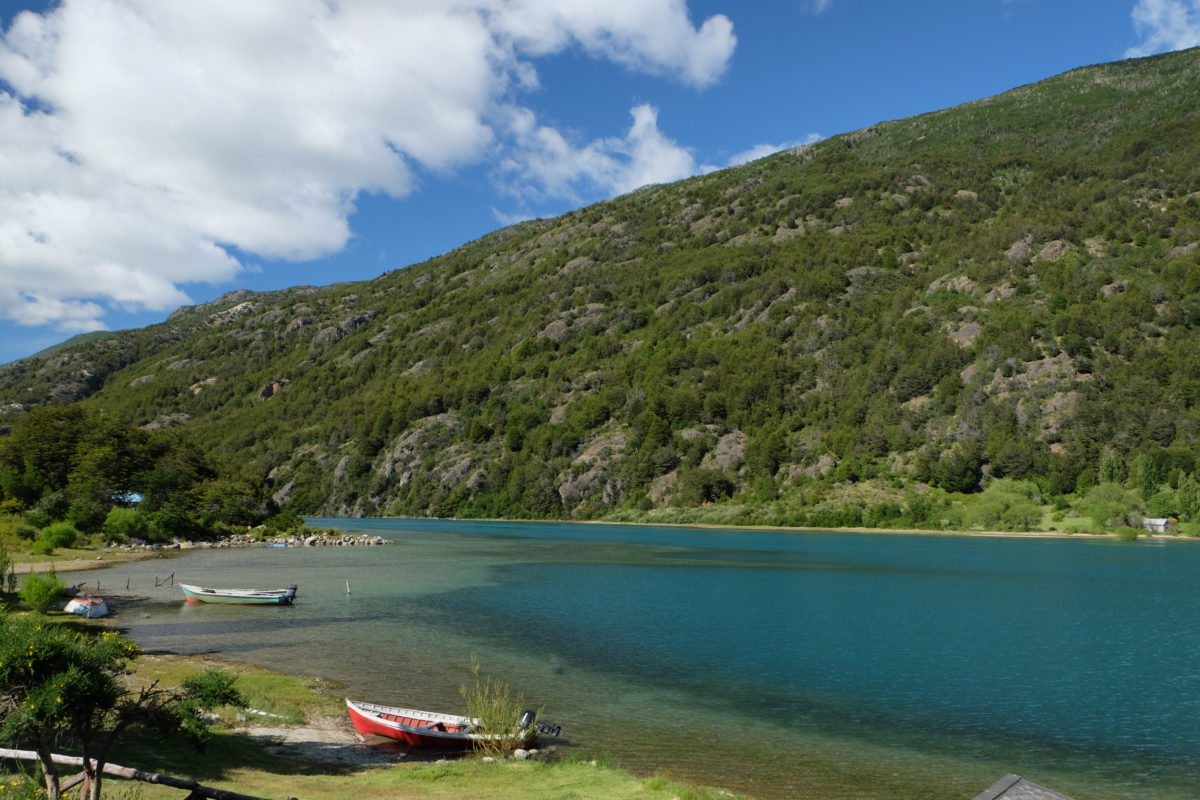The meetings continued in Coyhaique. When I was walking back from picking up my laundry I saw Tim and Timo entering town, who will stay here tomorrow.
The fuel bottle for my camp stove was almost empty, so I’d been looking for white gas for a while, but unable to find it. Thus I went to a fuel station before leaving the city and had it filled with regular petrol. The lady operating the pump filled the bottle all the way to the brim, so now I have too much fuel to cook safely.
Saturday 2 December
| Elapsed Time | Moving Time | Distance | Average Speed | Max Speed | Elevation Gain |
|---|---|---|---|---|---|
|
08:16:00
hours
|
06:38:40
hours
|
96.35
km
|
14.50
km/h
|
52.56
km/h
|
1,546.00
meters
|
Today’s goal is as simple as it is hard: Cross the highest pass on the Carretera Austral to Villa Cerro Castillo. The top is at about 1100 meters, but the climb has more altitude gain because of some downhill parts before the top.
The climb is long and gentle most of the way, so I could keep a reasonable pace. Early on I had to wait a while for some road works and here I met two Australians on bike. I rode with them for a bit, but soon had to leave them behind, since I still had a long way to go. The road was rather busy, but thanks to the waiting for the road works all vehicles arrived in large convoys and the road was otherwise empty. After the road to the nearest border crossing split from the “main” road it got a lot quieter.
It’s interesting how the landscape is different every day. This morning I wasn’t riding through forest, but through wide grass-covered valleys dotted with farms. This changed in the second half of the ride, when I was riding in river valleys again. The trees returned, but at the top of the pass I was close to the tree line and there was also still some snow left near the road, even if it had been rather warm recently. Then followed the descent with an amazing series of switchbacks which took me to Villa Cerro Castillo.




Today’s ride has the largest amount of climbing on the tour by quite a large margin and I don’t expect to beat this record. This was also the last 1000+ meter pass, as I’m staying below 600 meters from now on. Despite all that, it wasn’t too hard, just a long day.
I stopped at a place with camping as well as a dorm room. To get a good night’s rest after such a long ride I decided to get a bed, which isn’t much more expensive than camping anyway. If you think people riding their bikes here are crazy, think again. Also here was a guy walking north from Punta Arenas (!), pulling a rather heavy-looking cart.
The hostel is sitting right at the end of the tarmac. If my information is correct the rest of the Carretera Austral is completely unpaved outside of the few settlements I’ll encounter. But to compensate for that I should be able to finish it on time with much smaller rides than today’s.

Sunday 3 December
| Elapsed Time | Moving Time | Distance | Average Speed | Max Speed | Elevation Gain |
|---|---|---|---|---|---|
|
07:32:20
hours
|
05:34:40
hours
|
65.65
km
|
11.77
km/h
|
29.88
km/h
|
840.00
meters
|
The next morning I thoroughly enjoyed the final 20 meters of paved road before getting on the gravel. Today I have a few smaller hills to climb and the first started right away. The road here was very bad, so even on the downhill I barely made 10 km/h. Later on the surface improved to the usual quality here in Chile.

On the second descent was an impossibly beautiful viewpoint. Here I talked to a German who cycled to Ushuaia in 2004 and visited Patagonia often. He gave some advice on the route to take and confirmed that the weather this year is much better than usual. You get what you deserve I suppose. He also asked if I had had many technical issues, to which I said no.


There was no wood to knock on, so of course I jinxed it with that answer. Soon after our meeting my rear mudguard broke and got stuck. The easiest solution is to just remove it, so that’s what I did. There goes my hard-earned Ruta 40 sticker 🙁 . “Luckily” I hadn’t found a Carretera Austral sticker yet, so I’m not losing that too. I’m sure I can find replacements online when I get home. As I was making sure no cables rubbed against the tire (MOAR zip ties!), a family stopped to ask if I needed help. Since I was almost ready to go I said no, but I used the opportunity to have them dispose of the useless mudguard, so I wouldn’t have to bring it on the bike.
Then just one hill was left, but this one was much easier due to the better road. The descent is very steep with loose gravel, so I had to go extremely slowly. At the end is a little abandoned house sitting by the river, where I’ll spend the night. I got a little past halfway to Puerto Rio Tranquilo and all serious hills until then are behind me.

Two hours later I was joined by Bata and Daniel, who had left before me at the hostel that morning. They didn’t know I was here, since all my stuff was inside the house, so they were quite surprised to see me. The sunset over the river was nice and we enjoyed it with some wine they brought. Just today I realised that I’m not going to use my thermos bottle for tea in this weather, so I might as well bring wine in it when I’m wild camping. The super cheap wine in cartons (3000 pesos for 2 litres) is quite good here. And they also have smaller portions that will more or less fit in the bottle. I had set up my tent in a room that would be almost completely dark with the door closed, which greatly helps me sleep.
Monday 4 December
| Elapsed Time | Moving Time | Distance | Average Speed | Max Speed | Elevation Gain |
|---|---|---|---|---|---|
|
06:09:52
hours
|
03:58:00
hours
|
55.42
km
|
13.97
km/h
|
32.76
km/h
|
670.00
meters
|
Monday’s ride started off well. The road is good and has no large hills, but a few short and steep sections to keep me awake. It took a while for the sun to show up, but once it did everything was great again. At first I was riding next to the river, which later flowed into Lago General Carrera, the second largest lake in South America after Lago Titicaca in Peru/Bolivia. This lake is also shared, between Chile and Argentina.



Somehow my backpack kept sliding to the right. I don’t know why it’s doing that, everything should be in the same place as always. But of course that’s nothing an extra bungee cord can’t solve.
Shortly after reaching the lake I had to wait quite a while for a section of road being regraded. It’s interesting how the road workers are all men, but the people sitting at either end to control traffic are always women. Not just here, I noticed the same in Argentina and Bolivia.

The last bit was harder again with some nasty climbs. The steepest was just outside town on a short section of pavement stones, but I could just barely keep the bike moving. Next time it gets this steep I’d better push. As I rolled into Puerto Rio Tranquilo I saw two other bike tourers who were just discussing where to stay. They were going to check out the camp sites, but I first went for lunch. I had already seen a sign announcing pizza, so the choice wasn’t hard. Combine that with a good beer and I’m all set.
Eventually I went to a combined campsite/hostel and I got a private room for the price of a dorm bed, so I’m not complaining. Outside is a bike with the rear wheel removed which I think is William’s, but I didn’t see him yet.
I met him when I returned that night after having a few beers with Bata and Daniel. His luggage rack had broken and he somehow managed to lose his quick release axle on the road. Thus he had to take a bus back to Coyhaique today to get repairs and new parts, but he plans to continue tomorrow as well.
Tuesday 5 December
| Elapsed Time | Moving Time | Distance | Average Speed | Max Speed | Elevation Gain |
|---|---|---|---|---|---|
|
02:21:28
hours
|
01:48:52
hours
|
20.07
km
|
11.06
km/h
|
29.88
km/h
|
465.00
meters
|
Tuesday marked the attack of the horseflies. On the first climb out of the village I had my very own cloud of them annoying me and trying to bite me. They are easy to swat, which is somewhat satisfactory, but I don’t always have a free hand for that. The ride continued along the lake and it’s very beautiful out here.

At 20 kilometres I heard a cracking sound and something rubbing my tire. It was what I already feared: My luggage rack had broken too. It’s aluminium, so not that easy to repair. I don’t think I can fix it in such a way that I can continue now, so I need a welder. My best shot is probably in Cochrane, some 100 km on.
After going through all the negative thoughts and ingesting a significant amount of a sugary liquid to activate my brain, I remembered I have all these extra letters in front of my name saying I’m a doctor and an engineer, though not a mechanical one. Time to start thinking about solutions instead of problems. Soon enough I saw a potential hack. I used my other remaining bungee cord to keep the rack in position. I also moved my panniers forward and rerouted some of the other straps to lessen the load on the rack. That means I have a bit less freedom to turn my handlebars, but I don’t need that while riding anyway. Maybe this will hold long enough. Let’s try this!
Update: As you can see in the comments, Nazca, the bike’s manufacturer, contacted me as they were reading my blog. They stated that this is an extremely rare manufacturing defect which hadn’t happened to a Gaucho in several years. They offered to replace the rack under warranty when I get back and suggested a better temporary fix. So despite the inconvenience I’m happy with the way they dealt with the issue.


| Elapsed Time | Moving Time | Distance | Average Speed | Max Speed | Elevation Gain |
|---|---|---|---|---|---|
|
06:08:24
hours
|
04:07:56
hours
|
47.81
km
|
11.57
km/h
|
25.56
km/h
|
736.00
meters
|
Note: I had already turned off my tracker when I figured I could still continue, so I have two partial tracks for this day.
Soon after I got moving again a stretch of bad washboard started, so everything got tested right away. Even the cars were moving slowly here. For now the rack seems to be holding up well. I’m a little bit careful to avoid the worst bits or go slower if I can’t avoid these, but generally the ride is going quite well. There were some more very good viewpoints and not too many hard climbs.
By the time I got to Puerto Bertrand I had worked out in my head a few potential semi-permanent solutions for the rack that don’t involve welding aluminium. I still need someone with a workshop to make it. According to the lady at the hostel there’s no such person in Puerto Bertrand, but tomorrow in Cochrane there should be plenty of mechanics.


Wednesday 6 December
| Elapsed Time | Moving Time | Distance | Average Speed | Max Speed | Elevation Gain |
|---|---|---|---|---|---|
|
05:40:04
hours
|
04:20:32
hours
|
47.18
km
|
10.86
km/h
|
28.80
km/h
|
912.00
meters
|
Wednesday I left the lakes and rode along the Río Baker. I stopped at its confluence with the Río Neff and walked to the viewpoint. The rapids just before are very impressive. Other than that the road was more of the same. Sometimes bad gravel, but the last 10 km were very good and just a few small but nasty hills.






I made it to Cochrane without more technical difficulties, so time for a rest day. Cochrane likes to call itself la última frontera, or in proper 24th century English the final frontier, because this is the last serious sign of civilisation until the end of the Carretera Austral some 230 kilometres south.
Distance covered: 332.2 km. Total so far: 4238 km.

Hey DR. McGyver Stef, doe kèns waal zègke dae wanjelieër mèt die cart is nog gekker as wae, mer aan die ker kan lichtig minder kepot gaon as aan diene fiets.
Höbse `m óngertösse vaerdig ? en daonao mèt Bata en Daniël borrele as ich Bata zien bericht good laes ???
Laot `m uch sjmake, gooi reis wiejer zónger groeate stökke en toet weer.
Nou Stef sjoën verhaole en prachtige foto’s! Toch maar aafkloppe op hout…… geneet nog van dees sjoëne reis!
Groetjes van ôs!
Ich gegriep bès waal det dien fototoestel äöveroore meuktj. De ein foto is nog sjoeaner as de anger. Waat ein prachtige, imposant gebied.
Helaas, de bagagedrager toch overbelast geraakt. Er is een duurzamere oplossing: koop twee flinke slangklemmen van ca. 10 cm (autogarage) en vind een blok hout. Als je me een e-mail stuurt, stuur ik je foto’s hoe je het moet aanpakken, mocht je geïnteresseerd zijn.
Monique, Nazca
Ook ter voorkoming van nog meer schade.